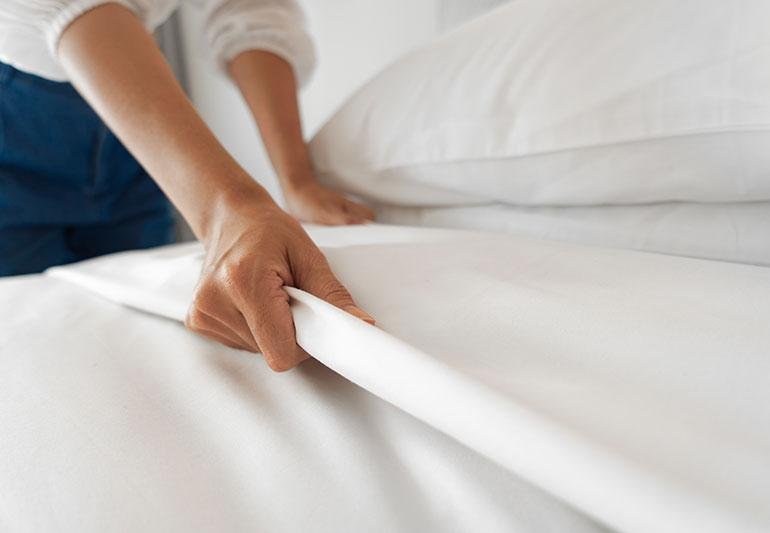How Often to Change Bed Sheets to Avoid Hidden Germs
How often to change bed sheets is a question many overlook, yet we spend nearly a third of our lives in bed. Our sheets and pillows can become a breeding ground for bacteria, fungi, mites, and viruses due to sweat, saliva, dead skin cells, and food crumbs.

It’s not just humans that love our beds. Microscopic creatures thrive in the warm, moist environment we create each night. From dust mites feasting on dead skin to fungal spores lurking in pillows, your bed may be far less hygienic than it appears.
Dust Mites, Skin Cells, and Why Clean Bed Sheets Matter
Humans shed around 500 million skin cells per day. These skin flakes, trapped in bedding and pillows, provide a buffet for dust mites. Unfortunately, both mites and their droppings are known to trigger asthma, eczema, and allergies. Even if you feel clean, your bedding may still be loaded with allergens.
Bacteria in Bed: Not Just a Hospital Problem
Bed sheets can harbor dangerous bacteria. In one study, hospital linens were found to carry Staphylococcus, a genus of bacteria commonly found on skin. While some strains are harmless, others can cause acne, skin infections, or more serious issues like pneumonia—especially for people with compromised immune systems.

According to microbiologists, even healthy people shed large amounts of bacteria while sleeping. If these bacteria enter the body through wounds or cuts, they can cause serious infections.
Can You Catch Illness from Dirty Bed Linen?
Absolutely. In studies conducted across various settings, E. coli and other dangerous pathogens have been found in unwashed bedding. Research has even shown that changing the bed linen of a person infected with a virus like mpox (formerly known as monkeypox) can release particles into the air, increasing the risk of transmission.
Fungal Spores in Your Pillow: A Hidden Health Risk
Pillows are particularly prone to fungal build-up. One investigation found pillows in daily use—some up to 20 years old—were full of Aspergillus fumigatus, a fungus commonly found in soil. These spores flourish in the heat and moisture from our heads during sleep, often going undisturbed for years.

Washing pillows may not fully remove the fungi. Many species can survive water temperatures up to 50°C (122°F). Ironically, laundering a pillow might increase its moisture content, making it even more hospitable to mold.
Breathing Risks: Who Should Be Concerned?
Exposure to fungal spores might not be a problem for most healthy people. But for individuals with asthma, sinusitis, or weakened immune systems—such as those recovering from tuberculosis, chemotherapy, or serious viral infections—the spores can be dangerous. In some cases, they may cause chronic lung conditions or severe fungal infections like invasive aspergillosis, which damages lung tissue.
How Often to Change Bed Sheets and Pillows
So what’s the solution? Here are some expert-backed recommendations:
- Change bed sheets once a week, or more often if pets sleep in your bed or you sweat heavily at night.
- Replace your pillow every two years if you’re healthy.
- Replace pillows every 3 to 6 months if you have asthma, respiratory issues, or chronic sinus problems.
- Launder bedding in hot water (above 60°C/140°F) to kill bacteria, mites, and fungi.
- Use allergen-proof covers for mattresses and pillows to reduce exposure to dust mites.
Habits That Make Your Bed Dirtier
Several habits can make your bed a hotspot for germs:

- Sleeping without showering
- Wearing unwashed socks to bed
- Letting pets sleep on the bed
- Eating or drinking in bed
- Not removing makeup before sleep
Each of these introduces additional oils, dirt, and microorganisms that accumulate quickly in sheets and pillows.
Clean Sheets, Healthier Sleep
If you’ve ever wondered how often to change bed sheets, the answer might be sooner than you think. Regularly cleaning your bedding is more than a matter of comfort—it’s a vital step toward protecting your health. For most people, changing sheets weekly and pillows every two years is a simple way to reduce exposure to allergens and harmful microbes.
Those with specific health concerns should be even more diligent. Your bed may look clean, but a microscopic world is lurking beneath your pillowcase. Cleaning more often—and replacing old bedding—might be the easiest health upgrade you can make.





Nice post. I learn something totally new and challenging on websites
There is definately a lot to find out about this subject. I like all the points you made
This is really interesting, You’re a very skilled blogger. I’ve joined your feed and look forward to seeking more of your magnificent post. Also, I’ve shared your site in my social networks!